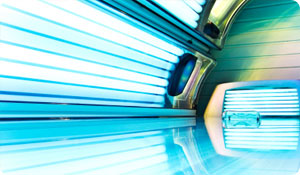
We know how damaging the sun's rays can be, but there's a common misconception that tanning beds are safer because they emit a higher concentration of the "browning" UVA rays than the "burning" UVB ones. In fact, tanning beds accelerate the sun's effects by 3x, so the chance for overexposure is even greater. And the long-term effects range from premature aging to terminal cancer. Here are five things you'll protect by staying away from tanning beds:
1. They Can Make You Look Older
Overexposure to both UVA and UVB rays speeds up skin's aging process, causing an increase in wrinkles, leathery skin, and photo-aging. Exposure to the UV rays breaks down your skin's elastin and collagen fibers, leading to sags and folds. You may not see the damaging effects for years, which puts young people particularly at risk, since they may not recognize the problem until it's too late.
2. They Can Damage Your Eyes
Though you wear goggles, studies show you have an increased chance of developing cataracts, and causing retinal damage and macula degeneration. Intense UVB exposure could also cause Photokeratitis - or "snow blindness" -- which feels like a extremely painful sunburn on your eyes.
3. They Can Weaken Your Immune System
Overexposure to sun - both natural and artificial - can weaken your body's immune system. According to the World Health Organization, UV radiation can heighten your sensitivity to sun, ability to fight basic viruses, and the effectiveness of your immunizations. For example, someone with Herpes might find a flare-up or frequent cold sores, even if they're taking maintenance medication.
4. They Can Interact with Medications
If you're taking any prescription medication, like antibiotics, birth control pills, or even topical skin ointments, using a tanning bed could lead to cosmetic or drug induced sensitivity, effectively increasing the effects of the UV exposure.
5. They Can Increase Your Cancer Risk
Studies show that UV rays can lead to three different types of skin cancer: basil cell sarcoma, squamous cell carcinoma, and the melanoma, which kills more than 8,000 people every year. The UV rays damage the body's DNA, leading to mutations that affect your body's automatic anti-cancer defense system. The lifetime melanoma risk is 75% greater for those who use tanning booths regularly before the age of 30. And the International Agency for Research on Cancer recently re-classified sunbeds as a top-tier cancer threat, along with known carcinogens like arsenic, asbestos, and cigarettes.
The bottom line: While the tanning bed industry still debates the fact that their products are harmful, the medical community has proven that they are. Still longing for a bronzed bod? Try a spray tan or tinted cream.
Sources:
The Health Physics Society
http://hps.org/hpspublications/articles/uv.html
The Lancet:
http://www.thelancet.com/journals/lanonc/article/PIIS1470-2045(09)70213-X/fulltext
The Food and Drug Administration
http://www.fda.gov/ForConsumers/default.htm
World Health Organization
http://www.who.int/uv/faq/uvhealtfac/en/index2.html





